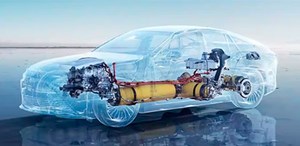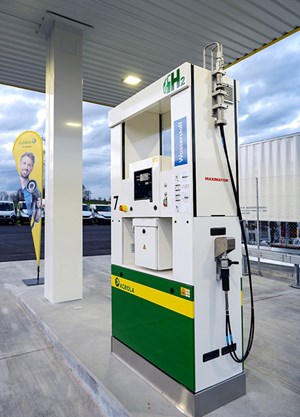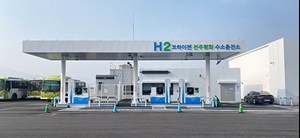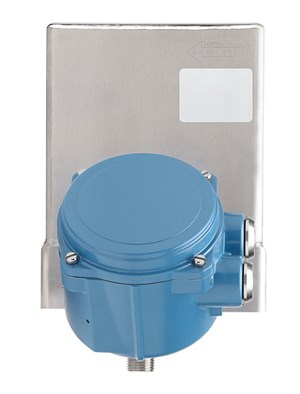Articles
New flow metering technologies for H2 fuel cell vehicle refueling sites
Special Focus: Hydrogen Mobility and Transportation
G. FULTZ, Emerson, Boulder, Colorado
When most people think of zero-emission vehicles (ZEVs), the concept suggests an electric motor drive supplied by a rechargeable battery. This can apply to automobiles, trucks, buses, industrial vehicles and railroad locomotives. However, another category of ZEVs does not use batteries, but instead generates power using a fuel cell as a battery alternative. These fuel cell electric vehicles (FCEVs) can cover the full range of vehicles, with the possible exception of the smallest, such as a bicycle (FIG. 1).

While there are several commercialized fuel cell technologies, the one most suited to mobile applications is the proton exchange membrane (PEM), thanks to its high-energy density, scalability, relatively low operating temperature and general simplicity. These units use pure hydrogen (H2) as fuel, combining it with atmospheric oxygen to produce an electric current to drive a motor, with only water vapor as a byproduct. The downside of PEM designs is its use of a precious metal catalyst. However, if a unit is scrapped, the catalyst is easily recoverable for recycling.
Regardless of what technologies are eventually adopted for widespread use, H2 fueling stations and precise methods for measuring the amount of fuel transferred to vehicles will be required. Newer flowmeter technologies address this issue with innovative designs, which have been proven in use over the past few years.
Fuel cells vs. batteries for ZEVs. This creates a question: how extensively could fuel cells replace batteries for transportation? One of the major concerns about the practicality of converting to ZEVs on a global scale is the availability of batteries. Supplies of lithium and other rare metals are constrained, and practical battery recycling technologies are still being developed.
This leaves fuel cells as an effective alternative, boasting a set of advantages over batteries. For example, when comparing an FCEV to the same vehicle with batteries, it can be refueled much faster, and it will retain the fuel indefinitely, unlike batteries, which lose power steadily, even when not in use.
While FCEVs as consumer cars and SUVs are rare, H2 fuel cells are widely used for industrial material-handling vehicles, such as forklifts. This approach is practical since it is unnecessary to depend on widely distributed external H2 refueling infrastructure. The plant or warehouse receives compressed H2 via a truck from the local supplier—much like other industrial gases—and can place refueling stations in the facility wherever needed. For general transportation, H2 refueling stations have a main storage tank that can be supplied via truck, just as with gasoline and diesel (FIG. 2).
When used in this manner, H2 fuel cells have several advantages over batteries:
- Vehicles can be refueled with H2 much more quickly than charging a battery—minutes vs. hours.
- Battery output declines as power is consumed and can drop as it reaches the discharge limit, whereas fuel cell output is constant.
- Fuel cells have a higher initial cost than batteries, but because they can be refueled faster and do not degrade over time, lifecycle costs are often lower, especially for fleets of vehicles.
Pressure to maximize fuel capacity. The idea of powering a vehicle fueled by compressed gas is nothing new. Propane works well and has a high capacity since it remains liquid even when the pressure is below 14 bar (200 psi). Compressed natural gas is also used, with pressures typically between 200 bar–250 bar. Higher pressures have been adopted as the standard to realize the highest practical H2 energy density. For large trucks and commercial vehicles (with some flexibility for tank size), 350 bar is the standard, but 700 bar use is growing. For cars and other small vehicles, 700 bar is the standard.
These are very high pressures, and all equipment must be designed to handle potential safety issues. Moreover, this is complicated because people using the equipment may not be trained. An average person coming into a service station wanting to fill a car with H2 must make the hose connection properly and without assistance, so the equipment must be highly durable, and user-friendly in many critical ways.
Fueling vehicles with H2. Like any fueling stop, filling a car or truck with H2 is an exercise in custody transfer. The same concepts apply as when buying gasoline or diesel: a flowmeter must provide a totalized volume to calculate the applicable price. Since money changes hands based on the measurement, accuracy is paramount. For large-scale custody transfer applications, international metrology standards call for a maximum allowable shift in the accuracy of ±0.167% compared to an international reference standard, even with disturbed flow conditions present.
Unlike liquid fuels, H2 must be sold by mass since a volume measurement requires correction for pressure and temperature. A flowmeter that measures mass natively instead of volume is thus far simpler to implement, and it avoids complexity with additional measurements and calculations.
The most widely used technology for mass flow measurement is Coriolis, known for its high accuracy and wide turn-down range. It is a preferred method for custody transfer measurements on a large scale for hydrocarbons, chemicals and gases. However, applying it, or any flowmeter technology, to H2 is challenging due to the high pressures involved, as few off-the-shelf models can handle 700 bar daily.
Fortunately, the line sizes are small for refueling station service since the flowrates do not need to be very high. Typically, 1/8-in and 1/6-in [diameter nominal (DN)2 and DN3)] units are sufficient. This makes construction for high-pressure much easier.
Designing flowmeters for H2. Handling H2 presents various unique challenges. Its small single-atom size makes it more difficult to find leaks than any other gas, particularly at such high pressures. Sealing strategies capable of controlling much larger molecules (e.g., methane) may not be sufficient with H2. For example, to avoid product loss, some joints that were previously sealed with O-rings must be welded. The embrittling effect that H2 has on some common grades of stainless steel must also be considered, but this is well recognized, so more appropriate alloys are used.
The author’s company developed a flowmeter familya that has found successful adoption for H2 fueling applications (FIG. 3). All models in this group are rated far higher than 350 bar, and most exceed 900 bar due to the specific alloy XM-19 (austenitic stainless steel) used, chosen for its high tensile strength and resistance to H2 embrittlement.
This flowmeter series is widely used in Europe and has been adopted by various companies for their H2 vehicle fueling stations (FIG. 4). These stations can dispense H2 at either 350 bar or 700 bar to accommodate both commercial and consumer customers.

Since these flowmeters are being used in a custody transfer application where money and fuel are changing hands, they fall under relevant trade regulations, including the International Organization of Legal Metrology (OIML) standard OIML R 139-1, Compressed Gaseous Fuel Measuring System for Vehicles and Netherlands Measurement Institute (Nmi) certification.
The Nmi certification is especially important as the metrology organization has reported that many H2 dispensers have not yet been tested for metrological accuracy. As a result, measurements can vary significantly, negatively affecting station owners and FCEV drivers.1
Maintaining accuracy. Flowmeters in custody transfer applications require regular calibrations, but the technology and accuracy requirements determine the interval between those tasks. The author’s company’s flowmetera has meter verification software. This is not self-calibration, but it is instead a series of internal diagnostics able to determine if anything is happening to cause a loss of accuracy. For example, it can detect corrosion or erosion of internal parts.
The software can generate a time-stamped report, useful for inspectors and maintenance teams. Many agencies recognize these verification results as a valid work practice. When indications using this method show no signs of problems, calibration intervals can often be extended, reducing required maintenance and downtime.
The growth of H2. As more countries push for fewer internal combustion-powered vehicles, ZEV options grow in importance. Battery-powered EVs have taken the limelight for much of the public, but FCEVs will continue to grow in numbers, driven by constraints on battery supply chains and the clear advantages of fuel cells.
As shown by a recent incident that occurred in July 2023 while refueling a H2 bus in California, H2 refueling can be dangerous if not handled correctly by using proper procedures and components.2 One of the more critical components is the device used to measure H2 flow, as this demanding application requires careful evaluation and selection, including consultation with knowledgeable suppliers.
The growing availability of H2 (green and blue) will result in wider refueling infrastructure, making adopting FCEVs easier and more attractive. The right flowmeters will ensure the new infrastructure is accurate, efficient and robust.H2T
Notes
a Emerson’s Micro Motion high-pressure Coriolis flowmeters
LITERATURE CITED
1 NMi, “Hydrogen dispensers: A guide to calibration and certification,” August 2022, online: https://nmi.nl/hydrogen-dispensers-a-guide-to-calibration-and-certification/
2 Hydrogeninsight, “Engulfed in flames | Fuel cell bus in California destroyed after explosion during refueling,” July 2023, online: https://www.hydrogeninsight.com/transport/engulfed-in-flames-fuel-cell-bus-in-california-destroyed-after-explosion-during-refuelling/2-1-1488705
About the author

GENNY FULTZ is a marketing product manager for Emerson, responsible for Micro Motion products. Before joining Emerson, she worked in various marketing and manufacturing roles for process industry companies. Fultz earned BS and MBA degrees from Purdue University.



